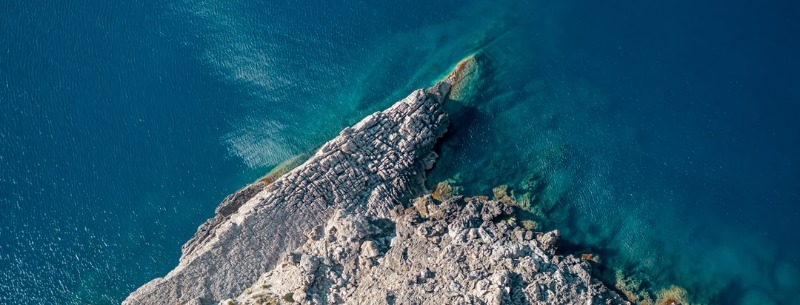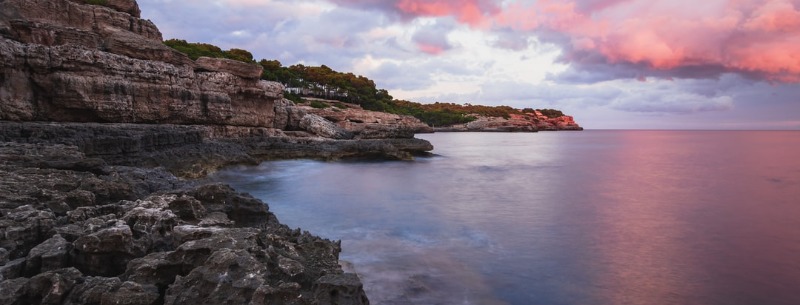Mallorca’s Best Beaches 2025
Few Mediterranean holiday spots are as often and as unfairly maligned as Mallorca. The island is commonly perceived as little more than sun, sex, booze and high-rise hotels – so much so that there’s a long-standing Spanish joke about a mythical fifth Balearic island called Majorca (the English spelling), inhabited by an estimated eight million tourists a year.
The island is about 100 kilometers from east to west and about 75 kilometers from north to south.
The spread of development, even after 50 years, is surprisingly limited, essentially confined to the Badia de Palma (Bay of Palma), a thirty-kilometer strip flanking the island capital, and a handful of mega-resorts notching the east coast. Elsewhere, things are very different.
Palma itself, the Balearics’ one real city, is a bustling, historic place whose grand mansions and magnificent Gothic cathedral defy the expectations of many visitors.
And so does the northwest coast, where the rearing peaks of the rugged Serra de Tramuntana harbour beautiful cove beaches, a pair of intriguing monasteries at Valldemossa and Lluc, and a string of delightful old towns – Deia, Soller and Pollenca as well as the picturesque villages of Biniaraix and Fornalutx.
There’s a startling variety and physical beauty to the land, too, which, along with the mildness of the climate, has drawn tourists to visit and well-heeled expatriates to settle here since the nineteenth century, including artists and writers of many descriptions, from Robert Graves to Roger McGough.
Alcudia – Balearic Islands, Spain
Moving south from Port de Pollenca, it’s just 10km round the bay to the pint-sized town of Alcudia , whose main claim to fame is its imitation medieval wall. Indeed, the whole place is overly spick and span, a poor reflection of the town’s historical importance.

Situated on a neck of land separating two large, sheltered bays, the site’s strategic value was first recognized by the Phoenicians, and later by the Romans, who built their island capital, Pollentia, here in the first century AD, on top of the earlier settlement.
The beach at Alcudia is one of the longest on the island.
Around Palma
For a day out from Palma, anywhere in the west or center of the island is readily accessible, but if you’re after a quick swim the most convenient option is to stick to the resorts strung along the neighbouring Badia de Palma (Bay of Palma).
Locals tend to go east on the #15 bus (every 10min; 30min) from Placa Espanya to the individual balneario (beach bar) sections of S’Arenal, where there’s an enormously long, if crowded, sandy beach.
Alternatively, you might be tempted by the Castell de Bellver (April-Sept Mon-Sat 8am-8pm, Sun 10am-7pm; Oct-March Mon-Sat 8am-7pm, Sun 10am-5pm; ?1.65, free Sun), a strikingly well-preserved fortress of canny circular design built for Jaume II at the beginning of the fourteenth century. The castle perches on a wooded hilltop some 3km west of the city center and offers superb views of Palma and its harbor.
Peninsula de Formentor
Heading northeast out of Port de Pollenca, the road clears the military zone at the far end of the resort, before weaving up into the craggy hills of the 20km-long Peninsula de Formentor, the final spur of the Serra de Tramuntana.
At first, the road (which suffers a surfeit of tourists from mid-morning to mid-afternoon) travels inland, out of sight of the true grandeur of the scenery, but after about 4km the Mirador de Mal Pas rectifies matters with a string of lookout points perched on the edge of plunging, north-facing sea cliffs.
From here, it’s another couple of kilometers to the woods backing onto the Platja de Formentor, a pine-clad beach of golden sand in a pretty cove. It’s a beautiful spot, with views over to the mountains on the far side of the bay. From May to October, you can get here from Palma and Port de Pollenca on a once-daily bus service, Monday to Saturday. At the end of the cove, opposite a tiny islet, stands the Hotel Formentor.
Beyond the turn-off for the beach, the main peninsula road runs along a wooded ridge, before tunneling through Mont Fumat to emerge on the rocky mass of Cap de Formentor, a tapered promontory of bleak seacliffs and scrub-covered hills which offers spectacular views.
Port De Pollenca
Over at Port De Pollenca things are a little more touristy, though still pleasantly low-key. With the mountains as a backcloth, the resort arches through the flatlands behind the Badia de Pollenca, a deeply indented bay whose sheltered waters are ideal for swimming.
The beach is the focus of attention, a narrow, elongated sliver of sand that’s easily long enough to accommodate the crowds, though as a general rule you’ll have more space the further southeast (towards Alcudia) you walk.
A rash of apartment buildings and hotels blights the edge of town, and the noisy main road to Alcudia runs close to most of the seashore, but all in all the place is very appealing, especially in the centre behind the marina, where old narrow streets hint at the resort’s origins as a small port and fishing harbour.
For a change of scene, water taxis shuttle between the marina and the Platja de Formentor, one of Mallorca’s most attractive beaches (April-Oct 5-7 daily; 30min). Also, boat trips cruise the bay (June to mid-Oct Mon-Sat 1 daily), or work their way along to Cap de Formentor (same times & price).
Port de Soller
Port De Soller is one of the most popular resorts on the west coast, and its horseshoe-shaped bay must be the most photographed spot on the island after the package resorts around Palma.
The high jinks of the Badia de Palma are about the last thing imaginable down here, though – the place is almost stiflingly staid.
Probably the best option is to make the fifty-minute stroll out to the lighthouse, which guards the cliffs above the entrance to Port de Sуller’s inlet. From here, the views out over the wild and rocky coast are spectacular, especially at sunset.
Directions couldn’t be easier as there’s a tarmac road all the way: from the centre of the resort, walk round the southern side of the bay past the beach and keep going along the seashore.
There’s no point in staying just for the swimming either, since, although the water is warm and calm, it’s often surprisingly murky (courtesy of the yachts at anchor), and the two sandy beaches are overlooked on all sides – by the road, hotels and restaurants.
Port de Soller heaves with cafes and restaurants, but standards are very variable: some serve up mediocre food with the package tourist in mind, others are more authentically Mallorquin – or at least Spanish.
